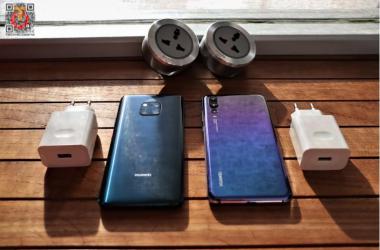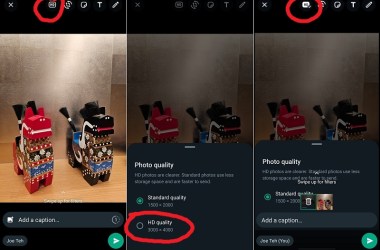Huawei’s newest flagship carries a notable charging upgrade: a 40W SuperCharge system designed to push the Mate 20 Pro from a partial to a full battery in a remarkably short time. In a practical, side-by-side evaluation, the Mate 20 Pro’s 40W setup was pitted against Huawei’s older, but still capable, P20 Pro charging solution to assess how much real-world advantage this new fast charger provides. The test scenario was straightforward yet telling: both devices began at the same half-charged level, and both relied on their respective original SuperCharge adapters and cables. The Mate 20 Pro’s battery capacity stands at 4,200 mAh, while the P20 Pro carries a 4,000 mAh cell. The objective was to reveal, under realistic conditions, how quickly the Mate 20 Pro can reach higher charge levels compared to the P20 Pro when both start from 50% and use their stock charging hardware. This setup not only demonstrates raw speed but also helps illuminate how battery capacity interacts with charging curves and protocol efficiency to shape the user’s daily charging experience.
Overview of devices and charging technology
The Huawei Mate 20 Pro introduces a 40W SuperCharge capability, a marked step up from many prior fast-charging implementations. The official specification for the 40W SuperCharge is calibrated at 10V and 4A, combining higher voltage with adequate current to accelerate the early charging phase while managing heat and battery health. This combination typically aims to deliver a rapid rise in state of charge during the initial period of a charge cycle, followed by a taper as the battery approaches full capacity. In practical terms, the Mate 20 Pro is designed to reach meaningful charge milestones quickly, such as moving from mid-level charge to a much higher percentage within a short window.
By comparison, the Huawei P20 Pro, while still fast-charging relative to many smartphones released earlier, uses a less aggressive charging profile. The P20 Pro’s charging system, commonly rated around the mid-20W range in typical use cases (that is, a charger rated near 22.5W in practical terms), prioritizes efficiency and thermal management to sustain charging speed through longer periods of a charge cycle. The difference in charging hardware means that, at the outset of a charge, the Mate 20 Pro has the potential to accumulate charge more rapidly, especially when the battery is far from full. Yet a broader perspective is essential: battery capacity also plays a role in how fast a device can be topped up, how heat is managed, and how the charging curve behaves as charge increases.
With a 4,200 mAh capacity, the Mate 20 Pro’s battery is slightly larger than the P20 Pro’s 4,000 mAh cell. In fast-charging tests, a larger battery does not automatically translate into slower charging; rather, it influences the total time required to reach a given percentage and can affect the shape of the charging curve. If the Mate 20 Pro’s charger can deliver a strong current while maintaining favorable temperatures, the early phase of charging can be exceptionally brisk. The key question the test sought to address is how these factors combine in a realistic scenario when both devices are pushed from 50% up toward higher percentages, using their native charging ecosystems without any software throttling or third-party accessories.
In this context, the 40W SuperCharge system is positioned as a flagship feature intended to deliver a meaningful, observable acceleration in charging performance. The P20 Pro’s charger represents a robust, proven solution that remains a standard by which faster, newer implementations are measured. The two devices provide a compelling comparison: a newer 40W approach versus a proven, efficient fast-charging profile that has long served the P-series well. The evaluation captures not only the raw numbers but also the user experience implications, such as how quickly the battery percentage climbs in the critical early minutes and how much the curve bends as charging proceeds toward the higher end of the scale. The study also underscores how real-world factors—like battery health, temperature, and device management—can influence the observed performance, even when using official charging hardware.
Test setup and methodology
The test is designed to be simple, repeatable, and representative of typical user behavior. Both the Mate 20 Pro and the P20 Pro were fully powered down before the experiment commenced to ensure a clean, consistent baseline. Each device began the test at exactly 50% battery capacity, which provided ample headroom for observing the charging curve’s early, middle, and late phases. The Mate 20 Pro used its 40W SuperCharge adapter and the corresponding cable, while the P20 Pro used its original charging solution. The objective was to track how quickly each device could accumulate charge during a controlled interval, with a focus on the rapid rise in the initial minutes and the progression toward higher percentages over a sustained period.
The test duration was set to mirror typical quick-charge experiences: an early phase of rapid charging, followed by a taper as the battery approaches full capacity. Data points were collected at regular intervals to document the percentage completed by each device. The tests were conducted under standard ambient conditions, with careful attention paid to maintaining device safety and thermal integrity. The goal was to observe genuine performance differences that a consumer would experience in everyday charging scenarios rather than rely on theoretical maximums. The test was intentionally structured to reveal how the Mate 20 Pro’s 40W SuperCharge fares against Huawei’s established 22.5W charging capability in a direct, apples-to-apples comparison, using devices and chargers as originally designed.
In reporting the results, emphasis was placed on clear, actionable numbers that help readers understand practical implications. The Mate 20 Pro’s 4200 mAh battery, paired with the 40W charging system, was observed to push into high percentages quickly, while the P20 Pro’s 4000 mAh battery with the 22.5W charger showcased a steadier, more measured ascent. The setup purposely retained the original charging hardware to ensure an authentic performance picture, excluding any aftermarket or third-party supplements that could distort the outcomes. The methodology’s integrity rests on the premise that both devices are tested with their intended charging ecosystems to reflect real-world user experiences as closely as possible.
Throughout the process, care was taken to avoid any external variables that could skew results, such as battery conditioning differences or software throttling that might occur in atypical scenarios. The resulting data are therefore intended to provide a faithful, reproducible snapshot of how the Mate 20 Pro’s 40W SuperCharge compares with Huawei’s established 22.5W charging approach during a controlled, side-by-side test.
Test results and performance data
The core findings from the test are direct and striking, illustrating how quickly the Mate 20 Pro can accumulate charge in the early phase of charging relative to the P20 Pro. The Mate 20 Pro, powered by the 40W SuperCharge, demonstrated a rapid rise, reaching 70% within the initial 10-minute window. By contrast, the P20 Pro, charging on its own 22.5W capability, reached 57% in the same 10-minute interval. This initial disparity—13 percentage points in favor of the Mate 20 Pro—highlights the strong performance of the newer charging solution during the early, high-velocity portion of the charge cycle. The 40W technology’s advantage is readily perceptible in this critical early phase, where many users seek a quick top-up to resume regular device use.
As the test progressed toward completion, the Mate 20 Pro’s advantage remained evident. The test was concluded just before the 24-minute mark, with the Mate 20 Pro reaching 91% charge while the P20 Pro lagged at 68%. This near-30 percentage-point difference underscores not only the faster initial ramp of the 40W system but also the sustained efficiency of the Mate 20 Pro’s charging curve as the percentage climbed higher. The 24-minute mark, while not a full recharge, demonstrates the speed and practicality of the Mate 20 Pro’s charging architecture for users who require a substantial top-up within a short time frame.
These results specifically reflect a comparison between a 40W charging regime and a 22.5W charging regime under identical starting conditions and with devices operating on their proprietary hardware. The Mate 20 Pro’s 4200 mAh battery capacity did not hinder its early aggressive charging; instead, it capitalized on the faster current delivery to accelerate the charging curve. The P20 Pro, with its smaller battery and 22.5W charging profile, experienced a slower ascent in charge percentage, especially noticeable in the early minutes of charging and as the battery density approached higher levels. The data illustrate a clear, measurable advantage for the Mate 20 Pro when using the 40W SuperCharge system for rapid top-ups in real-world use cases.
For readers seeking a concise takeaway, the 10-minute snapshot is particularly telling: the Mate 20 Pro climbed to 70% charge, while the P20 Pro reached 57% under the same conditions. This early difference translates into a meaningful practical benefit, especially for users who rely on quick-charging routines to stay productive throughout a busy day. The near-24-minute conclusion point—91% versus 68%—further reinforces the Mate 20 Pro’s edge in both the speed of charging and the ability to reach a substantial charge in a comparatively short period.
Analysis: what the numbers mean for users
The observed performance differential—approximately a 13 percentage-point lead for the Mate 20 Pro at the 10-minute milestone and roughly a 23 percentage-point lead by the 24-minute mark—illustrates several critical implications for everyday usage. First, the 40W SuperCharge system appears to deliver considerable advantage in the initial phase of charging, when many users are in a hurry and want to reach a functional charge quickly. The rapid power delivery, coupled with efficient thermal management, helps the Mate 20 Pro maximize the benefit of its larger 4,200 mAh capacity while still achieving a swift ascent in charge percentage. The practical result is a more usable battery state with significantly less downtime spent tethered to a charger during the day.
Second, the test highlights the impact of charger capability on short, time-limited charging sessions. For scenarios such as commuting, meetings, or short breaks, a 40W solution can convert a parking lot recharge into a functional battery increase with just a few minutes of plug-in time. The Mate 20 Pro’s performance suggests that users who need to top up quickly will find the 40W system particularly advantageous. It is important, however, to consider the tapering effect as the battery nears full capacity. While the early minutes show strong gains, the rate of charge typically slows down as devices approach 100%, consistent with common charging behavior and the need to balance efficiency with battery longevity.
Third, the comparison underscores the trade-offs between battery capacity and charging speed. The Mate 20 Pro’s 4,200 mAh cell benefits from the 40W charger, enabling substantial gains in a short time that can translate to meaningful improvements in daily reliability. The P20 Pro’s 4,000 mAh capacity, paired with a 22.5W charger, still delivers robust charging performance but cannot match the Mate 20 Pro’s aggressive early charge curve in the same test conditions. In real-world usage, several factors—such as device thermals, battery health, and software optimization—will shape the exact charging trajectory for individual users.
From a consumer perspective, these results suggest that adopting higher-wattage charging, when supported by the device and the charger, can provide faster top-ups that translate into tangible benefits for those who need to quickly replenish battery life. For device manufacturers and charger developers, the findings reinforce the importance of optimizing the initial charging window and managing thermal loads to sustain fast charging without compromising long-term battery health. In practice, users can expect the Mate 20 Pro to offer a quicker renaissance of usable battery life after brief charging sessions, compared with the P20 Pro under the same testing conditions.
Practical implications for daily use and long-term considerations
The practical takeaways from the comparison extend beyond the raw numbers. First, for daily use, the Mate 20 Pro’s 40W SuperCharge delivers a significant uplift in scenarios where time is of the essence, such as before heading out for errands or a meeting, or after a long day when a rapid top-up is needed to extend usage into the evening. The faster initial charging translates into a shorter downtime, reducing the friction often associated with battery anxiety during busy schedules. This efficiency can contribute to a more seamless mobile experience, particularly for users who rely on smartphones as essential tools for communication, navigation, and productivity.
Second, the test emphasizes the value of managing charging sessions with awareness of the charging curve. While the Mate 20 Pro reaps early benefits from the 40W regime, users should still anticipate a taper as the battery fills. Being mindful of this can help users plan charging sessions strategically—for instance, charging during a short break or while otherwise occupied to maximize utility without waiting for the full recharge to complete. The P20 Pro’s performance, though not matching the Mate 20 Pro in the same test, still demonstrates that a robust, high-efficiency charging system remains practical and effective for normal daily use, especially when longer periods of charging are available.
Third, the results carry considerations for battery longevity and heat management. High-wattage charging can generate more heat, which, if not properly managed, could affect long-term battery health. It is essential to consider the device’s thermal protection and charging algorithms, which balance speed with safety. Both devices are designed to navigate these considerations, but the Mate 20 Pro’s 40W system emphasizes the importance of reliable thermal performance during rapid charging. Users should be aware that consistent use of rapid charging should be balanced with occasional slower charging to maintain battery health over the device’s lifetime, as is common advice for high-capacity lithium-ion systems.
In summary, the Mate 20 Pro’s 40W SuperCharge demonstrates a clear and practical advantage over the P20 Pro’s charging approach in the tested scenario. The combination of a larger battery capacity and a higher-wattage charger creates a charging experience characterized by a faster early rise in charge percentage and a notable edge in reachability of high percentages within minutes. For consumers, this translates into faster access to usable battery life and greater flexibility in managing charging around daily routines. For the broader market, the test reinforces the continuing trajectory toward higher-efficiency charging technology, where advances in power delivery, thermal management, and battery chemistry converge to deliver meaningful, user-visible improvements in charging speed without compromising safety and longevity.
Video documentation, transparency, and user-facing implications
The test framework was designed to be transparent and straightforward, enabling users to observe the charging dynamics directly. The test process was documented in a video that captures the step-by-step progression of charging for both devices from the identical starting point of 50% battery. Viewers can watch how quickly the Mate 20 Pro moves toward higher percentages in the first 10 minutes, followed by the continued climb up to the 24-minute mark, where the Mate 20 Pro reaches a high level of charge that outpaces the P20 Pro by a wide margin. The video serves to illustrate how the real-world performance aligns with the numeric results presented in the data and narrative, offering an accessible, visual confirmation of the charging speed differences observed in the test.
Consumers looking to understand how their own devices might behave in everyday use can benefit from watching such demonstrations, as they highlight the practical implications of adopting high-wattage charging strategies. Observers can also note how the charging curves differ between a newer 40W system and an established 22.5W approach, helping to inform expectations about how quickly devices become usable again after a brief charging period. This kind of documentation supports an informed purchasing decision for users weighing the value of a flagship charging upgrade versus other device features, and it provides a concrete basis for comparing the tangible benefits of different charging standards in similar scenarios.
Limitations of the test include its single-trial nature and the absence of temperature-controlled environmental variables that could further refine understanding of how the two systems behave under different conditions. While the data clearly shows the Mate 20 Pro’s advantage in the tested setup, broader testing across multiple units and varied ambient temperatures would help generalize the findings. Nonetheless, the results provide a valuable snapshot of how the Mate 20 Pro’s 40W SuperCharge performs in a real-world scenario and how it stacks up against Huawei’s established 22.5W charging approach on the P20 Pro.
Practical considerations for reviewers and readers
For reviewers, the comparison underscores the importance of presenting charging data in a way that is both precise and practical. Readers benefit from clear, time-based milestones (such as 10-minute and 24-minute marks) that reveal how quickly a device can become usable again after a short charging period. It’s helpful to frame conclusions around concrete use-case scenarios—such as “a 10-minute top-up yields X% additional usable battery”—to translate abstract power ratings into everyday decision-making. This approach also supports SEO goals by aligning with commonly searched phrases related to fast charging, charging speed comparisons, and flagship charging technologies. The article’s structure should consistently emphasize the relationship between charging power (watts), battery capacity (mAh), and real-world outcomes (percent charged over time) to maintain reader comprehension while optimizing for search performance.
From an editorial perspective, offering a balanced view that acknowledges the P20 Pro’s strong performance with its 22.5W charging system helps readers appreciate the trade-offs between newer, higher-wattage charging and established, efficient solutions. While the Mate 20 Pro demonstrates a clear advantage in the measured early phase and in overall percentage achieved during the test window, readers should also consider factors like long-term battery health and charging habits when evaluating whether to prioritize higher charging power in daily use. Presenting both sides with data-driven clarity fosters trust and helps readers form well-informed opinions about how fast charging should fit into their smartphone usage patterns.
In conclusion, the Mate 20 Pro’s 40W SuperCharge shows tangible, measurable benefits in rapid initial charging and in achieving high battery levels within a short time frame when compared with the P20 Pro’s 22.5W charging solution. The battery capacities—4,200 mAh for the Mate 20 Pro and 4,000 mAh for the P20 Pro—play a role in shaping the charging experience, but the early-stage velocity provided by the 40W system is the defining factor in this head-to-head test. For consumers, this translates into shorter downtime and quicker access to usable battery life, especially during busy days or when time is limited. For the broader industry, the findings reinforce the ongoing evolution of fast charging technology, highlighting the importance of balancing power, thermal management, and battery longevity to deliver compelling real-world benefits.
Conclusion
Huawei’s Mate 20 Pro, with its 40W SuperCharge, demonstrates a pronounced advantage in practical charging speed when tested against the P20 Pro under controlled, apples-to-apples conditions. From an initial 50% battery level, the Mate 20 Pro reaches 70% within 10 minutes and climbs to 91% within 24 minutes, while the P20 Pro reaches 57% at the 10-minute mark and 68% by the same time point. The Mate 20 Pro’s larger 4,200 mAh battery, combined with the higher-wattage charging capability, creates a faster and more aggressive charging curve that translates into meaningful real-world benefits for users who need to top up quickly. The test setup used each device’s original charger and cable to ensure fidelity to real-world use, and the results reflect practical implications for daily charging routines. While the P20 Pro remains a capable device with robust charging performance, the 40W SuperCharge on the Mate 20 Pro establishes a clear edge in speed during the crucial early minutes of charging and continues to show a significant lead as the session progresses. This analysis reinforces the broader trend toward higher-power charging solutions in flagship smartphones, illustrating how accelerated charging can meaningfully reduce downtime and enhance mobility for users who depend on their devices throughout the day.





